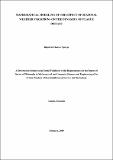| dc.description.abstract | A mathematical model to study the effect of seasonal weather variation on the dynamics of
plague disease is developed and analyzed. Apart from being historical, plague disease caused
by a gram negative bacteria called Yersinia pestis is still considered as a major threat around the
world. In this work we investigate three main forms of plague disease which are bubonic, septicemic
and pneumonic plague. It gives answers to various questions that relate to the complex
dynamics of plague disease and the effect of seasonal weather variation in its transmission and
spread. In particular we give answers to mainly four questions pertaining to the formulation
and analyses of the mathematical models of bubonic Plague, formulation and analysis of the
mathematical models of pneumonic plague, formulation and analysis of the combined mathematical
model for the dynamics of plague disease that includes all three forms of plague disease
and all major ways/modes of plague disease transmission. Lastly we formulate and analyze the
plague disease model incorporating parameters that are affected by seasonal weather variation
and study its effects on the dynamics of plague disease.
Using ordinary differential equations, we formulate a model for the dynamics of plague disease
in four settings namely: Human beings, Rodents, Fleas and Pathogens in the environment. We
compute the basic reproduction numbers and apply them to establish the conditions for local
and global stability of both disease free and endemic equilibrium points. We further assess
the effect of seasonal weather variation, in which we modify the transmission rates and take
them as sinusoidal functions. Using fundamental existence-uniqueness theorem, we were able
to prove the existence of positive periodic solutions. We then establish the conditions for local
and global stability of both Positive Periodic Solution (PPS) and Disease Free Solution (DFS).
The results show that the transmission and dynamics of bubonic plague are dictated by: the
rate at which fleas get infected; the infectious periods of fleas, rodents and human beings;
the probability that rodents and human beings survive the infected class; and the adequacy
of contact rates and the rate at which human beings and rodents become exposed to bubonic
plague disease. We also found that the environment condition, the abundance of pathogens in
the environment and the increase of the number of individuals with pneumonic plague greatly
influence the increase of pneumonic plague disease infectives. In the combined model, we
found that the variation in number of plague disease cases mainly depend on: the transmission
rate of infection from one individual to another; the incubation period of an individual and the
time that an individual remains infectious. The analysis further reveals that the effects posed
by seasonal weather variation depends on the extent to which the weather variation favours the
transmission of plague disease (amplitude of seasonality) and the duration that it remains in
favour of the increase or decrease of the rate of disease transmission and spread. Therefore the
control strategies should target these factors and parameters (the transmission rate of infection from one individual to another, the incubation period of an individual and the time that an
individual remains infectious) that according to our results stated above have shown to have a
significant effect on the dynamics of plague disease.
We thus recommend to the government, national security system and other health stake holders
that in order to have an effective way of controlling the disease we must ensure that there is
provision of education on plague disease infection, transmission and spread to raise peoples
awareness, continuous monitoring of factors that may lead to plague outbreak, easy access of
plague disease treatment for all and the strong collaboration with neighboring countries on
health related issues. | en_US |

